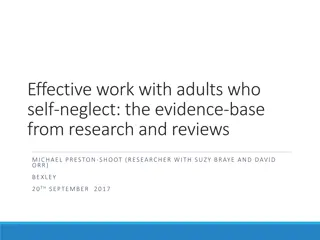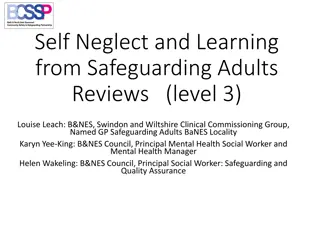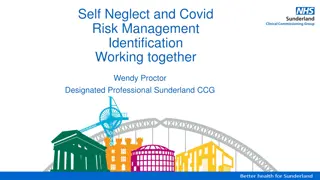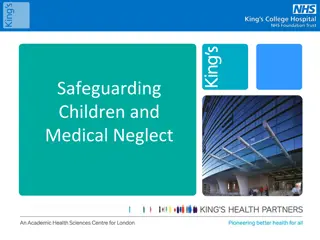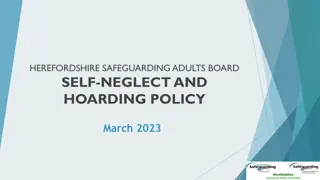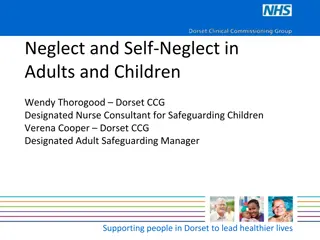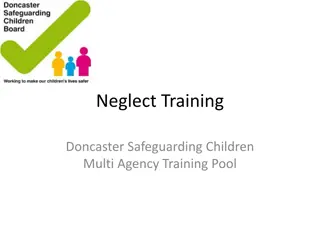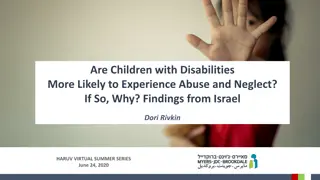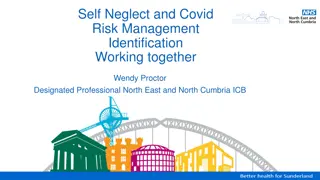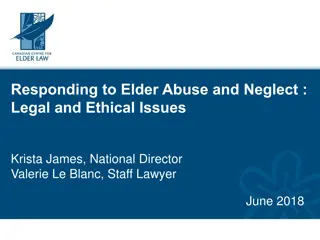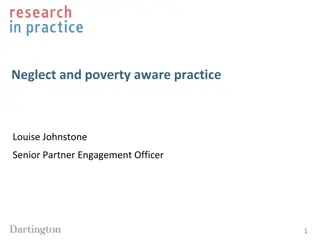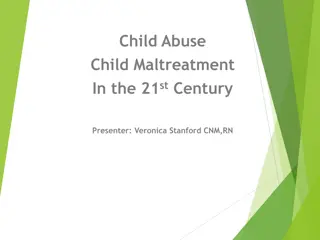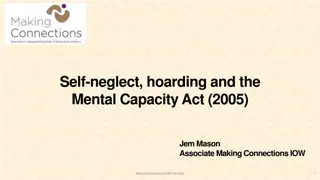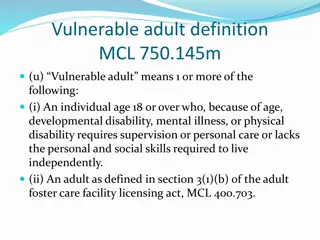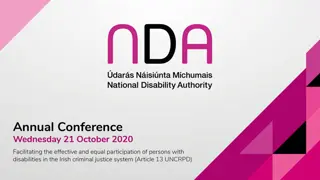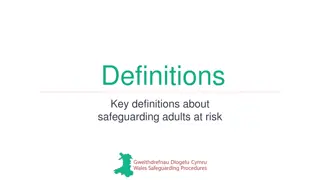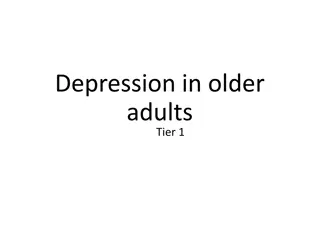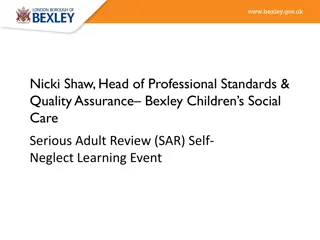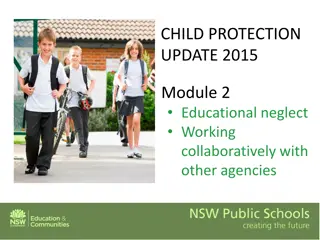Understanding Self-Neglect in Vulnerable Adults - Case Study
A case study detailing an individual, diagnosed with various mental health conditions, experiencing self-neglect and high risks, such as vulnerability to harm, self-harm, alcohol misuse, and homelessness. Despite past efforts, including supported accommodation, the individual faces multiple challenges, including breaches of orders leading to custodial sentences and homelessness post-release.
Download Presentation

Please find below an Image/Link to download the presentation.
The content on the website is provided AS IS for your information and personal use only. It may not be sold, licensed, or shared on other websites without obtaining consent from the author. Download presentation by click this link. If you encounter any issues during the download, it is possible that the publisher has removed the file from their server.
E N D
Presentation Transcript
SELF NEGLECT National Safeguarding Week Gabrielle Ormisher & Nichola Nelson Tuesday 22ndNovember 2022
What is self neglect? Lack of self-care to an extent that it threatens personal health and safety Neglecting to care for one s personal hygiene, health or surroundings Inability to avoid harm as a result of self-neglect Failure to seek help or access services to meet health and social care needs Inability or unwillingness to manage one s personal affairs (SCIE, 2022)
Case Summary Case A Female, Age 47, Lives alone, No family. Trustees manage finances. Diagnosis of Asperger s, Emotionally Unstable Personality disorder, Eating disorder and alcohol / substance misuse. History of self harm and harm to others. Closed to mental health services due to non-engagement with Psychological Therapies. Prescribed medication via GP. Open case to Mental Health Social Work Team, alcohol and substance misuse services, Police, Probation service. Criminal Behaviour Order in place. Repeatedly breaches often resulting in custodial sentence. Previous high levels of care including Supported Accommodation. On residing in supported accommodation risks of self-harm increased. Deemed to have mental capacity (accommodation, alcohol use). Alcohol / substances misuse impacts negatively on decision making process and making unwise decisions. Previous alcohol detox and rehabilitation.
Risks Risk of increased vulnerability from others including sexual assault, financial abuse, retaliation, cohesion and assault. Risk of harm to self history of self-harm including cutting, overdose and limiting dietary intake. Risk of death - history of self-harm including cutting, overdose and limiting dietary intake. Accidental and intentional risk of death through self-harm and alcohol misuse. Risk to others history of assault to others including Police and ex- partner resulting in hospital order. Risk of homelessness unsettled accommodation and limited options due to presentation and damage causes to properties.
Previously tried Client historically detained under Section 37 Mental Health Act 1983 (Hospital Order) following assault (stabbed ex-partner). Subject to Section 117 (aftercare) Mental Health Act 1983. Client had resided in Supported Accommodation however, self-harm risks increased as she disliked placement. Moved into community property. Multiple moves / evicted due to unsettled accommodation and anti-social behaviour. Multiple accommodations where tried and failed. Housing Solutions Team involved for housing guidance / options. Independent housing provider identified. Managed initially with minimal support of care provider and Mental Health social care team however, increased anti-social behaviour and risk to self (sexual assault, increased alcohol / substance misuse). Alcohol and substance misuse services involved. Police and Anti-social behaviour (ASB) team involved. Landlord supportive working alongside ASB Officer, Police, Probation and Mental Health social care team. Not wishing to evict from property. Issued with Community Behaviour Order (CBO). Repeatedly breached CBO and sentenced to short custodial sentences. Evicted from the property. On release from custodial sentences homeless. Staying in hotel accommodation. Repeatedly arrested due to breach of the peace. Intoxicated on arrest. Multiple multi agency professionals meetings held. Discussions re: accommodation options including historical supported accommodation and associated risks. Client able to purchase own property. Work undertaken with local Police regarding areas in Runcorn area with any ASB / community issues. Identified area and property. Property purchased. Risk of self-harm decreased. Client owning her own property increased self-worth and her wishes to maintain a habitable home environment. Varied levels of alcohol / substance misuse and engagement with alcohol / substance misuse services. Risk of self-harm reduced, risk from others reduced as would not allow strangers back to her owner occupied tenancy, independence increased travelling further afield and attending local AA meetings. Ongoing breaches of CBO however on release from custody returned back to her property with support of Mental Health social care, Probation, Police and alcohol / substance misuse services. Joint collection by Mental Health social care and Police from custody who would explain CBO conditions and assess mental capacity (CBO and alcohol use) on release due to client not being intoxicated.
Theory Crisis Theory Time limited Relieving immediate problems To make connections with previous events Building individuals resources of coping .how individuals have coped with a crisis in their lives, particularly one involving a mental health problem. (Caplan, G. (1995) Principles of Preventative Psychiatry, London, Tavistock)
Theory Strengths based approach Focuses on individuals strengths (including personal strengths and social and community networks) and not on their deficits (SCIE, 2022) Holistic Multi-disciplinary to promote the individuals well-being Outcomes led and not services led
Essential skills Non-judgemental Person-Centred Building of rapport, trying to break down barriers Partnership working Observational skills Effective communication with adaptable communication methods Active listening Interpersonal skills Emotional intelligence Openness and transparency Empathy
Values and Ethics Respect for Human Rights Support, protect and empower Dignity Well-being Promote Empowerment Personal values Professional values
How to support - Use of appropriate legislation (Human Rights Act 1998, Care Act 2014, Mental Capacity Act 2005, Mental Health Act 1983) Care Management / Risk Management Plan. Joint working with all agencies involved (Police, Care staff, alcohol / substance misuse services, probation, safeguarding and health services) involved or make referrals. Escalate to partner agencies if not involved. Professionals Meetings, Self-Neglect Panel, Legal Advice Panel (LAP), MAPPA, MARAC with all partner agencies involved. Discuss multi agency plan / options to reduce / minimise risks. Formulate plan. Critical risk - request Risk Enablement Panel.
Legislation, Policies and Procedures Mental Capacity Act (2005). Care Act (2014) The Care Act 2014 clarified the relationship between self-neglect and safeguarding and made self-neglect a category of harm about which the Local Authority has a duty to make enquiries and to assess need with the promotion of wellbeing at the heart. Mental Health Act (1983) Human Rights (1998) Article 5 right to liberty and security, Article 8 respect for your private and family life. Self Neglect Policy HBC https://adult.haltonsafeguarding.co.uk/docs/selfneglectpoli cy.pdf
HBC Self Neglect Policy - Aims and objectives - Individuals are empowered as far as possible, to understand the implications of their actions There is a shared multi-agency understanding and recognition of the issues concerning self-neglect There are effective multi-agency working practices in place Concerns received regarding self-neglect are prioritised appropriately There is a proportionate response to the level of risk to self and others These aims and objectives can be achieved by Promoting a person-centred approach which supports the right of the individual to be treated with respect, dignity and to be in control of, and as far as possible, to lead an independent life Increasing knowledge and awareness of self-neglect including relevant legislation Promoting a proportionate response to self-neglect and approach to risk assessment Clarification of different agency and practitioner responsibilities in order to aid identification of a lead agency, when required Promoting an appropriate level of intervention through a multi-agency approach Principles The most effective approach to hoarding and self-neglect is to use consensual and relationship-based approaches. These may be more effective if carried out by, or in partnership with, non-statutory parties including but not limited to family members; friends; housing associations; charities and voluntary sector organisations Hoarding and self-neglect will be approached in the least restrictive manner unless there is evidence that a clear risk of significant harm exists, which may require a non-consensual intervention The rights of individuals under the Human Rights Act 1998 will be supported and consensual interventions will be made unless there is evidence that a clear risk of significant harm exists which may require a non-consensual intervention Risk of harm should always be considered in terms of harm to the individual and harm to other people, for instance, neighbours A lead organisation has to be identified when it is necessary to coordinate interventions across multiple organisations to reduce risk of harm to an individual/community Leading and coordinating does not mean taking responsibility for carrying out all of the necessary work and interventions
Outcomes - Reduction in risk to self - No self harm, reduction in others visiting her home address Reduction in alcohol consumption outside of the home address Positive engagement with Social Care, Alcohol services, Probation and Police No issues from neighbours or complaints of ASB Less Crisis Intervention Settled in own home Sadly passed away. Acute alcohol toxicity
What learning and reflection? Gibbs Reflective Model 1988 Feelings and Analysis Non judgemental approach Positive risk management What learnt from the experience? Gaps in support alcohol services outreach Future learning?????????
THANK YOU Any questions?


